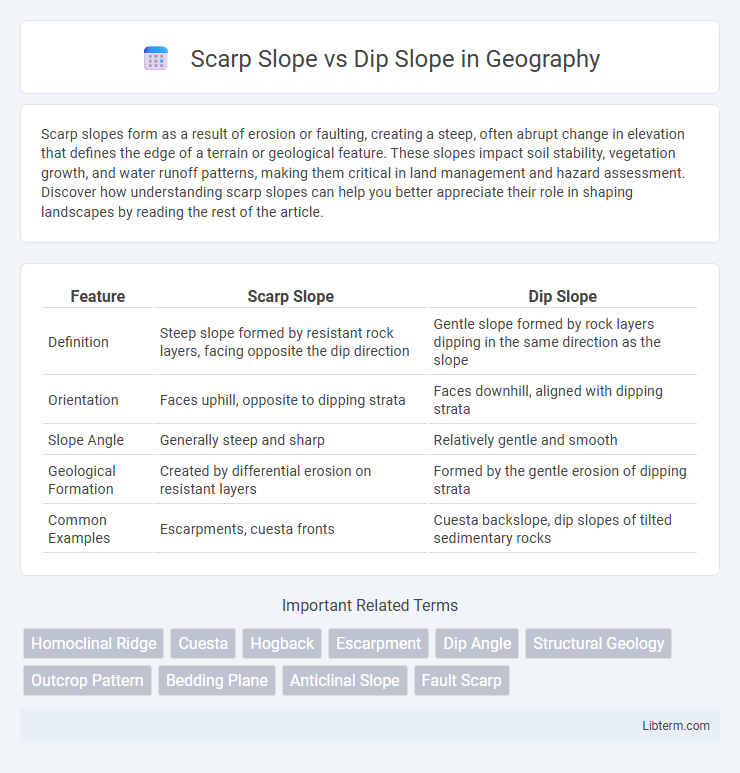Scarp slopes form as a result of erosion or faulting, creating a steep, often abrupt change in elevation that defines the edge of a terrain or geological feature. These slopes impact soil stability, vegetation growth, and water runoff patterns, making them critical in land management and hazard assessment. Discover how understanding scarp slopes can help you better appreciate their role in shaping landscapes by reading the rest of the article.
Table of Comparison
| Feature | Scarp Slope | Dip Slope |
|---|---|---|
| Definition | Steep slope formed by resistant rock layers, facing opposite the dip direction | Gentle slope formed by rock layers dipping in the same direction as the slope |
| Orientation | Faces uphill, opposite to dipping strata | Faces downhill, aligned with dipping strata |
| Slope Angle | Generally steep and sharp | Relatively gentle and smooth |
| Geological Formation | Created by differential erosion on resistant layers | Formed by the gentle erosion of dipping strata |
| Common Examples | Escarpments, cuesta fronts | Cuesta backslope, dip slopes of tilted sedimentary rocks |
Introduction to Scarp Slope and Dip Slope
Scarp slope, also known as a cuesta slope, is a steep, often cliff-like slope formed by the differential erosion of tilted sedimentary rock layers, exposing resistant rock strata. Dip slope is the gentler, inclined surface parallel to the dip of the underlying rock bedding planes, usually facing the same direction as the strata's tilt. These contrasting slopes are key features in geomorphology, revealing the structural orientation and erosion patterns of folded or tilted sedimentary landscapes.
Definition of Scarp Slope
A scarp slope is a steep slope or cliff formed by faulting or erosion, representing the exposed edge of a geological formation such as a cuesta or cuesta-like ridge. This slope typically faces opposite the dip direction of the underlying rock layers, contrasting with the gentler dip slope that follows the rock strata's inclination. Understanding scarp slope morphology is crucial in geomorphology for interpreting structural geology and landscape evolution.
Definition of Dip Slope
A dip slope is a geological formation where the surface of the land gently follows the angle of the underlying rock strata, creating a slope that aligns with the dip of the rock layers. In contrast, a scarp slope is characterized by a steep, usually abrupt, incline formed by erosion or faulting, cutting across rock strata. The dip slope's gradual incline reflects the natural bedding planes of sedimentary rocks, making it less steep than the often rugged and erosive scarp slope.
Geological Formation Processes
Scarp slopes form due to differential erosion where resistant rock layers create steep cliffs by retreating unevenly, often influenced by faulting or folding processes. Dip slopes develop by the gradual weathering and erosion along inclined sedimentary rock strata, following the rock layer's dip angle and creating a gentle, sloping surface. Both slopes reveal structural geology features, with scarp slopes highlighting abrupt tectonic activity and dip slopes indicating stratigraphic layering and erosion dynamics.
Key Differences Between Scarp Slope and Dip Slope
Scarp slopes are steep, rugged landforms formed by the resistant rock layers eroding slower than adjacent softer layers, creating sharp cliffs or escarpments. Dip slopes exhibit gentle inclines that follow the dip angle of geological strata, often composed of less resistant rocks that erode more uniformly. The key difference lies in their formation and morphology: scarp slopes are characterized by abrupt elevation changes due to differential erosion, while dip slopes represent gradual bedding plane surfaces aligned with rock dip direction.
Visual Identification on Landscapes
Scarp slopes are characterized by steep, abrupt inclines formed by erosion or faulting, often visible as sharp cliffs or escarpments contrasting with adjacent terrain. Dip slopes exhibit gentle, uniform inclines that follow the angle of underlying rock strata, creating smooth, gradual landscape surfaces. Visual identification relies on recognizing the distinct steepness and angularity of scarps versus the consistent, sloping nature of dip slopes aligned with geological layers.
Importance in Geomorphology
Scarp slopes, characterized by steep, erosional faces, are crucial in geomorphology for understanding tectonic activity and landscape evolution as they often indicate fault lines or erosional retreat. Dip slopes, with their gentle inclination matching underlying strata, provide insights into sedimentary layering and structural geology, influencing drainage patterns and landform development. The contrast between scarp and dip slopes helps geomorphologists interpret geological history, erosion processes, and rock resistance in landscape shaping.
Real-World Examples
Scarp slopes, characterized by steep, cliff-like faces, are exemplified by the Great Escarpment in Southern Africa, where resistant rock layers create dramatic elevation changes. Dip slopes, gently inclined surfaces parallel to rock strata, are well-illustrated by the cuesta landscapes in the Appalachian Mountains, formed by tilted sedimentary layers. These contrasting slope types influence erosion patterns, land use, and ecosystem distribution in their respective regions.
Implications for Human Activity and Development
Scarp slopes, characterized by steep, rugged terrain, often limit human settlement and infrastructure development due to increased erosion risks and construction challenges. In contrast, dip slopes with gentler gradients provide more stable land, facilitating agriculture, urban expansion, and transportation networks. Understanding these geomorphological differences is crucial for land use planning, hazard assessment, and sustainable resource management in hilly or mountainous regions.
Conclusion and Summary
Scarp slopes are steep, formed by resistant rock layers eroding away slowly, while dip slopes are gentler, following the angle of the underlying strata. The contrast in slope angles directly results from the rock's structural orientation and resistance to erosion. Understanding these differences aids in geological mapping, land use planning, and assessing erosion patterns.
Scarp Slope Infographic

 libterm.com
libterm.com